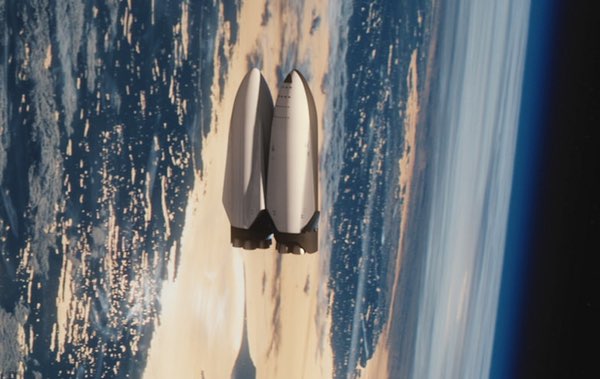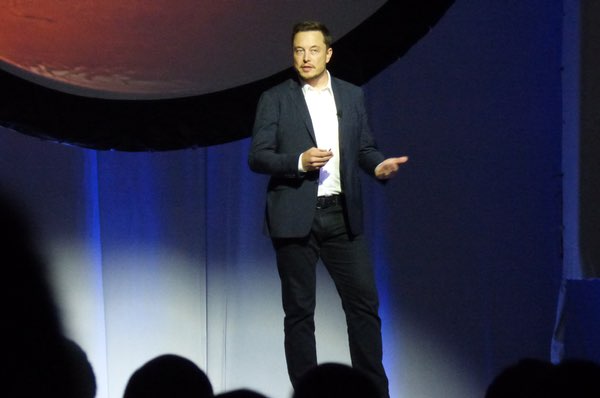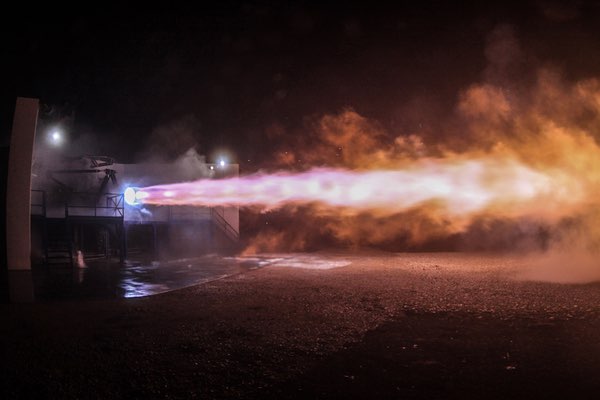Elon Musk’s road to Marsby Jeff Foust
|
| “Right now, you cannot go to Mars for infinite money,” Musk said. “You can’t get a self-sustaining civilization if the price is $10 billion a person.” |
That cultural clash, though, paled in comparison with what happened Tuesday, with the cosplayers long gone and the IAC in full swing. The conference’s plenary sessions, typically featuring panels of officials, often seem designed to minimize the news they create: a panel of space agency leaders the previous day, for example, offered a unified front in favor of technology development, international cooperation, and education.
Tuesday afternoon’s plenary, though, was different. Only one person would be speaking, and he planned to make news: SpaceX founder and CEO Elon Musk would, after months of anticipation, provide details on his Mars mission architecture that could be ready to send humans to Mars as soon as the mid-2020s. And, it turned out, there were plenty of Elon Musk fans among the more than 5,000 IAC attendees who were eager to learn every detail.
That meant lines formed outside the hall in the convention center hosting the speech hours before it was scheduled to begin. When the doors finally opened, shortly after 1:30 pm (the originally scheduled start time of the talk), those at the front of the line raced in, sprinting down the aisles to get the best available seats, as if they were at the real Comic-Con and attending a panel on the next Avengers movie.
And what did they, and others in attendance or tuning in online, get for their trouble? They received an extended speech from Musk, and a now-infamous question-and-answer session, that ran for an hour and a half. It was a talk that moved from the general rationales for making humanity multiplanetary—Musk’s oft-stated goal for SpaceX—to detailed technical information about the vehicles he believe can make that happen affordably. And yet, at the end of the day, after the crowds dispersed and the IAC resumed a sense of normalcy, many questions remained unanswered.
 A tanker spacecraft refuels a spaceship in Earth orbit prior to its departure to Mars. (credit: SpaceX) |
Unveiling the Interplanetary Transport System
While Musk started his remarks with a general discussion of why humanity should move beyond Earth, and why Mars was the logical next destination beyond Earth, people were curious about how he planned to make it happen. His choice of architecture, he said, was driven by economics.
“Right now, you cannot go to Mars for infinite money,” he said, given the lack of capability to send humans to Mars today. So-called “traditional methods,” patterned after Apollo, could make humans-to-Mars possible for $10 billion a person, he claimed. “You can’t get a self-sustaining civilization if the price is $10 billion a person.”
Achieving that “self-sustaining civilization” requires dropping the per-person price by several orders of magnitude. His goal: getting the price down to about $200,000, the media price for a house in the US today. “The probability of establishing a self-sustaining civilization is very high” if that goal can be achieved, he said. “Enough would want to go and who could afford the trip that it would happen.”
Achieving that, he said, requires four key elements. One, not surprisingly, is full reusability of the transportation system, something SpaceX has been pursuing for some time. Second is to make use of in-orbit refueling, so that a Mars-bound spacecraft would not have to launch from the Earth’s surface fully fueled. A third element is the production of propellants on Mars for the return trip to Earth, again saving on propellants otherwise needed to be launched from the Earth. The final one is the choice of propellant: Musk prefers methane over both kerosene and liquid oxygen given methane’s density, performance, and ability to be produced on Mars.
“These are the four elements that need to be achieved,” he said. “Whatever system is designed, whether by SpaceX or anyone, these are the four features that need to be addressed in order for the system to really achieve a low cost per person to the surface of Mars.”
With that, he showed a four-and-a-half minute video, which SpaceX released on YouTube shortly before his address, displaying the Interplanetary Transport System the company had designed. In it were animations of giant boosters lifting off, deploying similarly large spacecraft, then landing back on the same pad at Kennedy Space Center’s Launch Complex 39A, with a crane ready to stack another spaceship on top. Then the spacecraft, departing for Mars, reentering and landing on its engines, its spacesuited occupants standing at the hatch as it opened onto the Red Planet terrain.
“It’s quite big,” he said after the video, to applause and cheers from many in the audience. That, to be certain, was an understatement: the vehicles were of a scale rarely envisioned, let alone attempted, for space systems. “The funny thing is, in the long term I think the ships will be even bigger. This will be relatively small compared to the Mars interplanetary ships of the future.”
| “It needs to be about this size,” he said of the spceship, in order to be able to carry 100 people at a time plus cargo for each trip to Mars. |
While the vehicles of his architecture were large, they were also, to first order, relatively simple. He envisions just a single booster, launching a spaceship that could serve as either a Mars-bound spacecraft or a tanker that would help fuel that spaceship. That spaceship would have the ability to land on Mars (or the Moon, or the moons of other planets) and take off again to return to Earth or go elsewhere in the solar system.
Their scale, and not their simplicity, is what attracted everyone’s attention. The booster, with a spaceship stacked on top, comes in at 122 meters tall, about 10 percent taller than the Saturn V. It’s far more powerful, though, with a liftoff thrust of 128 million newtons, 3.6 times that of the Saturn V. As a fully-reusable vehicle—with the booster coming back for a landing—it can place 300 metric tons in low Earth orbit, compared to the Saturn V’s 135 tons. If the booster is not reused, and thus doesn’t need to reserve propellant for a landing, its payload capacity increases to 550 tons.
“It needs to be about this size,” he said, in order to be able to carry 100 people at a time plus cargo for each trip to Mars. Why 100? He said a “minimum threshold” for a self-sustaining human civilization on Mars is one million people, which means 10,000 trips at 100 people each, with the missions modulated by the Mars launch windows that open about every two years. “It’s probably somewhere between 40 and 100 years to achieve a fully self-sustaining civilization” for ships of that size. Smaller ships, he implied, would require more ships and/or more patience to achieve that Mars civilization goal.
Musk went fairly deep into the technical details about the booster and spaceship: details about their size, mass, and performance; cutaway diagrams of their interiors; and more. But he also wanted to emphasize that it’s not all PowerPoint charts and videos. A couple elements of the overall architecture are already in development.
One is the Raptor engine, the methane-liquid oxygen, or “methalox” engine that SpaceX has been quietly working on for a few years. The booster, for example, will use 42 Raptor engines, while the spaceship will have nine. The day before Musk’s talk, he tweeted photos of the first test of the engine, not disclosing how long it fired or when, other than just before the IAC.
“I was really excited to see that the team managed to do the all-up Raptor engine firing in advance of this conference,” he said. “Thanks to the Raptor team for working seven days a week to get this done in advance of the presentation. I really wanted to show that we had made some progress in this direction.”
Another area of progress is work on composite structures needed for the vehicles. Musk showed a photo of the first development tank of the size needed for the spaceship, a giant black structure dwarfing five engineers standing in front of it. SpaceX has already subjected that tank to cryogenic propellant tests. “Initial tests with cryogenic propellants actually were quite positive,” he said, with no signs of leaks of other issues.
 Elon Musk discusses his Mars mission architecture at the IAC September 27. (credit: J. Foust) |
Unanswered questions
While Musk went into details about the design of the booster and spaceship for his Interplanetary Transport System, many other aspects of the overall goal—a self-sustaining human presence on Mars—got far less detail.
| “Ultimately this is going to be a huge public private partnership,” Musk said. “That's probably what occurs.” |
In his talk, he played up the interior volume of the spaceship, which he said would provide its crew of 100 with plenty of room. “In order to make it appealing” and thus attract more people willing to go, he said, “it’s got to be really fun and exciting, and it can’t feel cramped or boring.” That means enough room for “zero-g games,” he said, along with spaces for movies and restaurants. “It’ll be, like, really fun to go.”
He didn’t, though, address some of the human factors issues associated with going to Mars: the effects of extended exposure to weightlessness, or of radiation during the trip to Mars, or any of the other issues that might affect the health of the crews.
Asked about that after his talk, he played down the radiation risks, calling it “relatively minor” and something that can be dealt with using shielding and storm shelters on the spacecraft.
At a later press conference about his speech, Musk suggested both radiation and microgravity were not major issues. “I think those are essentially solved problems,” he said.
And what happens when the crews land on Mars? Musk suggested that would be left open to others. “Once that transport system is built, then there’s a tremendous opportunity for whoever wants to go to Mars and create something new, or build the foundations of a new planet,” he said. “That’s really where a tremendous amount of entrepreneurship and talent will flourish.”
The biggest questions, and uncertainties, revolved around cost and schedule. Musk, in his speech, offered a timetable that suggested that the first spaceship and booster could be ready for testing by the early 2020s, with the first flight to Mars in the middle of the decade. “If things go super-well, we might be kind of in a ten-year timeframe,” he said.
He acknowledged, though, that schedule was highly uncertain. “We were intentionally kind of a bit fuzzy about this timeline,” he said. Earlier, he admitted to laughter from the audience, “I’m not the best at this sort of thing.” After all, SpaceX has set, and missed, many schedules in the past for development of other vehicle; the Falcon Heavy, for example, is now running several years late.
As for cost, Musk said only a small fraction of the company’s resources are being spent on the Mars plan. “Right now the resources that are being put into the Interplanetary Transport System are pretty low: certainly well under five percent of the company,” he said. “Maybe we’re spending a few tens of millions of dollars on it right now. So, it’s relatively small.”
That will grow, he said, as engineers shift from the Falcon 9 and Heavy and the Crew Dragon spacecraft to the transport system. “Within a year and a half to two years, we should have most of SpaceX engineering working on the Interplanetary Transport System.” That would increase spending to $300 million a year, he said, with ultimately an investment “on the order of $10 billion” before it starts generating revenue. (At just $300 million a year, though, it would take decades to get to $10 billion, a slower rate than a vision he projected of Mars-bound spacecraft in the mid-2020s.)
And where does that money come from? “Obviously it’s going to be a challenge to fund this whole endeavor,” he said. Some of it, he said, would come from “a pretty decent net cash flow” from SpaceX’s launch and ISS transportation activities, and perhaps the company’s interest in developing a broadband satellite constellation. Private investors could step in, too.
He acknowledged, though, that private money alone won’t develop this transportation system. “Ultimately this is going to be a huge public private partnership,” he said. “That's probably what occurs.”
 A Raptor engine, which will be used by the dozens to power the booster and spaceship, undergoes its first full-scale test firing shortly before the conference. (credit: SpaceX) |
Immediate and delayed reaction
For those in the room at the Expo Guadalajara, or watching the webcast, it seemed like Musk got a very warm reaction. There was plenty of applause, cheers, and standing ovations during the hour or so he talked, before turning it over to audience questions.
| “This is not just a series of launches or a series of space missions,” said Nield. “What we need to be thinking about instead is the development of an ecosystem, infrastructure, and a space economy.” |
And, oh, those questions. One person offered Musk a comic book created for him about living on Mars. Another was pitching Musk on a skit for the comedy website “Funny or Die.” A woman asked, “on behalf of all the ladies, can I go upstairs and give you a kiss, a good-luck kiss?” (He declined.)
That cringeworthy selection of questions from unadulterated fans of Musk can be traced back to that rush to get into the hall. There was one microphone that people could line up at to ask questions (a second was reserved for those in a press area). That microphone was up near the front, on one side of the hall. Those who waited for hours to get into the room, racing in as the doors opened to get the best seats, were just about the only ones to have a chance to ask questions; if you were sitting in the back, or simply up front but on the other side, you were out of luck.
As the week-long IAC progressed, the phenomenon of the Musk speech and audience reaction faded. In the halls of the Expo Guadalajara, and various receptions, restaurants, and other gathering spots, people talked and raised questions about Musk’s plans. Could he really build a rocket and spacecraft like what he described? How could he pay for it? And how long would it really take, if he could both find the money and overcome the technical hurdles.
In conference sessions, people tended to offer polite, if non-committal, assessments of SpaceX’s Mars architecture when the inevitable questions arose. At a panel about Moon and Mars exploration the day after Musk’s talk, space agency officials carefully avoided strongly endorsing or opposing the plan.
“It’s no surprise to me that all of them, of course, are mentioning Mars,” said Jan Wörner, director general of the European Space Agency, lumping Musk in with Jeff Bezos and other space entrepreneurs. “I’m quite sure that these companies are interested also in going to the Moon.” Wörner has long been promoting his “Moon Village” concept for an international lunar base, but Musk, in his speech, only mentioned the Moon in passing, noting the spaceship included in his architecture could land and take off from its surface.
“We love the plans,” said Dava Newman, NASA deputy administrator. That apparent strong endorsement, though, was tempered by the fact that she then talked generally about partnerships with companies, and not the specifics of SpaceX’s Interplanetary Transport System.
“To help this to be successful, the most important thing is to be willing to think about this in a new and different way,” said George Nield, the FAA’s associate administrator for commercial space transportation. “This is not just a series of launches or a series of space missions. What we need to be thinking about instead is the development of an ecosystem, infrastructure, and a space economy.”
Does SpaceX’s Interplanetary Transport System fit into that? On the one hand, Musk claims that it will create “a tremendous amount of entrepreneurship” for those who make it to Mars. On the other hand, it requires very little infrastructure in space: the boosters and tankers shuttle up and down, while the spaceships head to Mars and back. Infrastructure like fuel depots, orbital habitats, and the like seem unnecessary in this approach, so focused on getting as many humans to Mars as quickly as possible.
If that’s all you want to do in space—at least until you’re ready to head to the moons of Jupiter and Saturn, as Musk suggested was possible by “planet-hopping” through refueling—then this system might well be the way to go. Those wanting to establish a human presence closer to home, like the Moon or cislunar space, might find it less attractive.
Less than a week after his speech, it’s far too soon to either declare his vision the one true path to Mars, or write it off as unworkable or unaffordable. It has, at the very least, stimulated a new discussion about how to go to Mars, and by whom.
